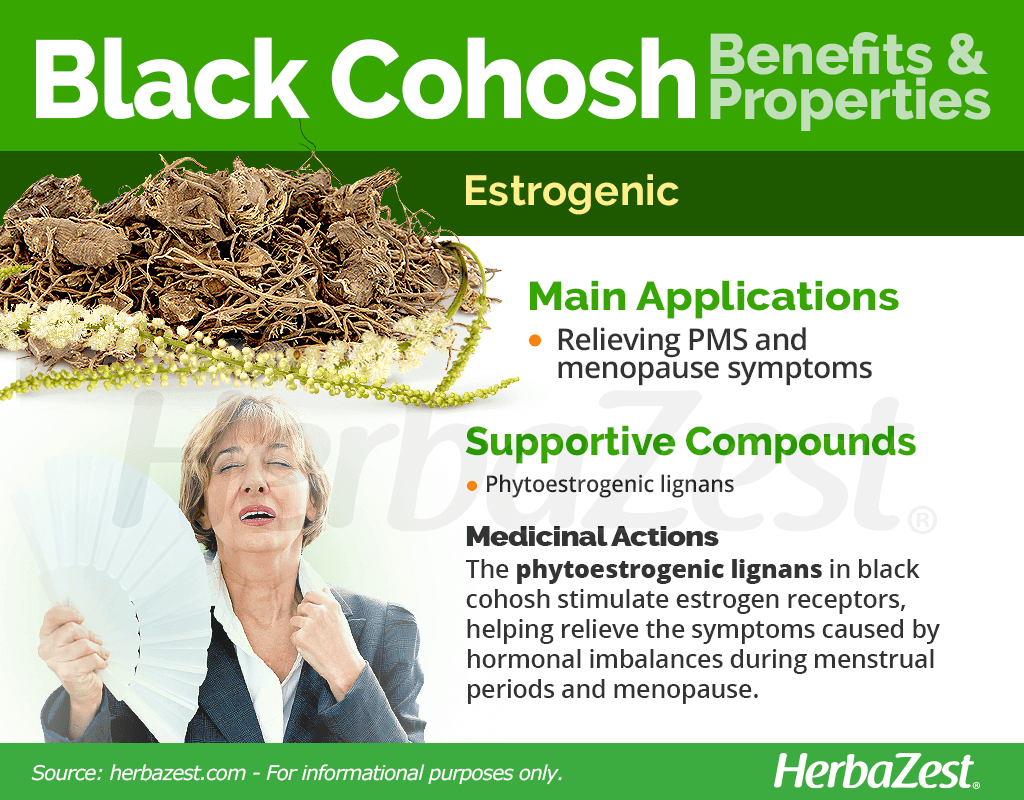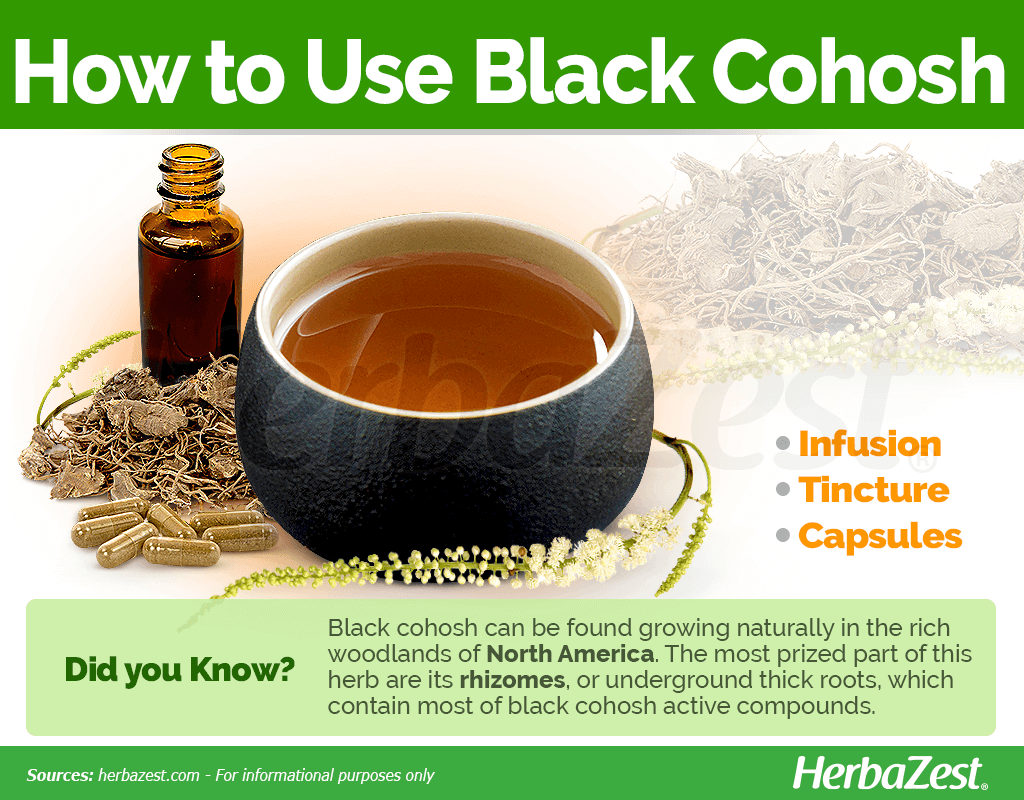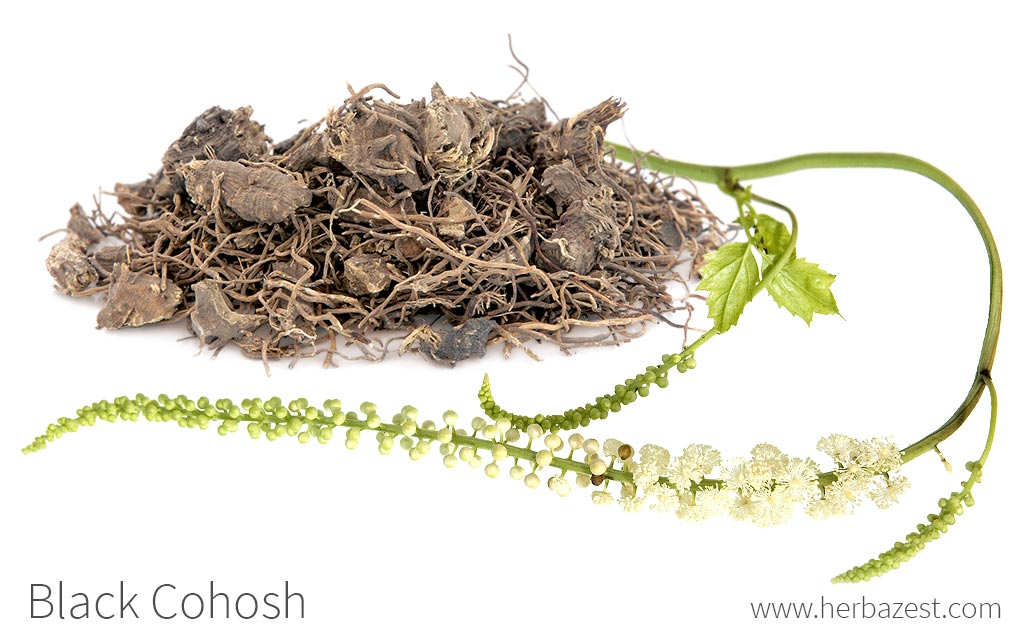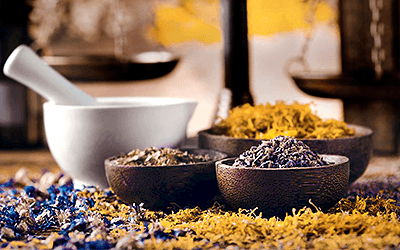Black cohosh, also known as black bugbane and black snakeroot, among other names, has been a popular medicinal herb in North America for centuries, and it is still valued to this day. Black cohosh modern applications are focused on treating the symptoms of menopause and menstrual complaints.
Black Cohosh Medicinal Properties
Health Benefits of Black Cohosh
Black cohosh properties have been used for centuries to treat a wide variety of conditions. However, modern scientific research suggest that black cohosh health benefits may be primarily useful for the following purposes:
Relieving PMS and menopause symptoms. Due to its estrogenic benefits, black cohosh is arguably the most popular natural medicine to treat the symptoms of premenstrual syndrome (PMS) and menopause.
Additionally, black cohosh properties may be effective for:
Preventing osteoporosis. Black cohosh estrogenic effects are thought to prevent bone loss and the onset of osteoporosis, however more research is necessary to corroborate this claim.
Treating arthritis. Some research suggests that black cohosh may help relieve the inflammation caused by arthritis when used in combination with other herbs.
How It Works
The main active ingredients in black cohosh are phytoestrogenic lignans, some of which (most notably, actaealactone) are unique to this plant.
The phytoestrogenic lignans in black cohosh are chemically similar to human estrogen and stimulate estrogen receptors around the body, which means they can help relieve symptoms related to estrogen deficiency, usually caused by hormonal imbalances during menstrual periods and menopause.
BLACK COHOSH CONTAINS PHYTOESTROGENS, WHICH MAY ACT LIKE ESTROGEN IN A WOMAN'S BODY.
Other herbs with estrogenic properties are alfalfa, dong quai and soy, all of which can help restore hormonal health in women. Although it lacks estrogenic properties, maca root contains active compounds that stimulate the endocrine system, regulating the production of hormones and relieving menopause symptoms.
Black Cohosh Side Effects
The compounds found in black cohosh may cause some adverse effects, such as stomach discomfort, headaches, weight gain, or breast tenderness. Reports show that excessive consumption of black cohosh may cause liver damage.
Cautions
It is important to note that black cohosh should not be taken for more than six months, since there is some evidence that long-term use may cause a slight increase in the risk of diseases associated with the breasts and uterus. Because more long-term studies need to be done on black cohosh, it is not advised to mix it with other medication.
In addition, black cohosh has a few major contraindications: women who are pregnant or breastfeeding, as well as those who have a past history of hormone-related cancers or liver disorders should not take black cohosh.
- Medicinal action Estrogenic
- Key constituents phytoestrogenic lignans
- Ways to use Capsules, Hot infusions/tisanes, Tincture
- Medicinal rating (3) Reasonably useful plant
- Safety ranking Use with caution

How to Consume Black Cohosh
Black cohosh is not regarded as an edible herb, so its consumption is usually done through infusions or supplements.
Among herbal medicine practitioners, the most prized part of this plant are its rhizomes, or underground thick roots, which provide all black cohosh health benefits in high concentrations.
Natural Forms
Infusions. The roots and rhizomes of the plant can brewed. This slightly bitter infusion can help relieve pain and promote hormonal balance in women.
Herbal Remedies & Supplements
Tincture. This is a concentrated preparation that needs to be diluted in water in order to reap the benefits of herb. The general guideline for black cohosh dosage is from 20 - 80 mg, once or twice a day.
Capsules. In its supplementary form, black cohosh can be taken daily, in fixed doses to relief specific conditions, such as premenstrual syndrome or menopause symptoms.
- Edible parts Root
- Taste Bitter

Growing
The black cohosh plant can be found growing naturally in rich woodlands from as far north as Maine and Ontario, south to Georgia, and west to Missouri and Indiana. This herbaceous perennial can reach eight feet (2.4 m) tall when mature.
Growing Guidelines
Black coshoh herb can be reproduced by seeds, but the germination rate is very low, so the preferred methods of propagation are root divisions or rhizome cuttings.
The optimal range of temperatures for growing a black cohosh plant is 66 - 77°F (20 - 25°C)
Black cohosh grows best in moisturized, rich, heavy soils which are preferably partially shaded, with a pH of 5.1 - 6.0.
This plant needs generous amounts of water to thrive. The soil must be kept most at all times; however, over-watering should be avoided.
This is a slow-growing plant. It may take over a year for the first shoots to emerge.
The black cohosh herb is susceptible to be attacked by cutworms, blister beetles, slugs, and snails.
- Black cohosh can also be affected by fungal diseases, such as damping off.
More detailed information about growing black cohosh can be found in the herb garden section.
- Life cycle Perennial
- Harvested parts Roots, Rhizome
- Light requirements Partial shade
- Soil Peaty
- Soil pH 5.1 – 5.5 (Strongly acidic), 5.6 – 6.0 (Moderately acidic)
- Growing habitat Cool temperate regions, Woodlands
- Propagation techniques Root cuttings
- Potential insect pests Beetles, Slugs, Cutworms, Snails
- Potential diseases Fungi, Damping-off
Additional Information
Plan Biology
The black cohosh plant, also known as black bugbane, black snakerrot, bug root, and fairy candle, is an herbaceous perennial that forms long leaves of up to three feet (1 m) in length and possesses a thick rhizome, or bulbous root, that can reach 24 inches (60 cm) deep.
Classification
Black cohosh, or Actaea racemosa, also known as Cimicifuga racemosa, is a member of the Ranunculaceae family, which contains around 1,700 species spread worldwide over 60 genera. This large group often goes by the name of buttercup or crowfoot family, and predominately contains flowering plants, including healing herbs like goldenseal (Hydrastis canadensis) and hepatica (Hepatica americana).
Related Species
Actaea racemosa (syn. Cimicifuga racemosa) is one of the 20 recognized species within the Actaea genus (former Cimicifuga genus). Close relatives of the black cohosh herb are baneberry (Actaea spicata), white baneberry (Actaea pachypoda), and red baneberry (Actaea rubra).
Historical information
The black cohosh plant was originally domesticated by the native peoples of North America before records began, and it was used primarily against menstrual problems, coughs, and muscle pain. When the first settlers arrived to American lands, they quickly adopted this traditional remedy, and European physicians started prescribing black cohosh around the mid-19th century to treat nervous disorders.
Economic Data
The main economic importance of black cohosh is as an herbal medicine used to treat disorders related to menstruation and menopause. In 1998, black cohosh root consumption was approximately 700,000 lbs (317,515 kg), but in 1999, only 183,000 lbs (83,000 kg) were consumed worldwide, although the market sharply increased again to 420,000 lbs (190,000 kg) by 2001. In that year alone, the black cohosh industry was worth around $2.25 million USD, and it is predicted to keep rising.
Other uses
Black cohosh has gained some popularity in recent years as an ornamental plant.
Sources
- Journal of Clinical Oncology, Randomized trial of black cohosh for the treatment of hot flashes among women with a history of breast cancer, 2001
- Oxidative Medicine and Cellular Longevity, A Review of Pterostilbene Antioxidant Activity and Disease Modification, 2013
- Spring Wildflowers of the Northeast: A Natural History, p. 4
- Encyclopedia of Herbal Medicine, p. 82
- American Cancer Society, Black cohosh
- Phytomedicine, Analysis of thirteen populations of black cohosh for formononetin, 2002
- Royal Horticultural Society, Actaea racemosa
- Alternative Medicine Review, Cimicifuga racemosa, 2003







